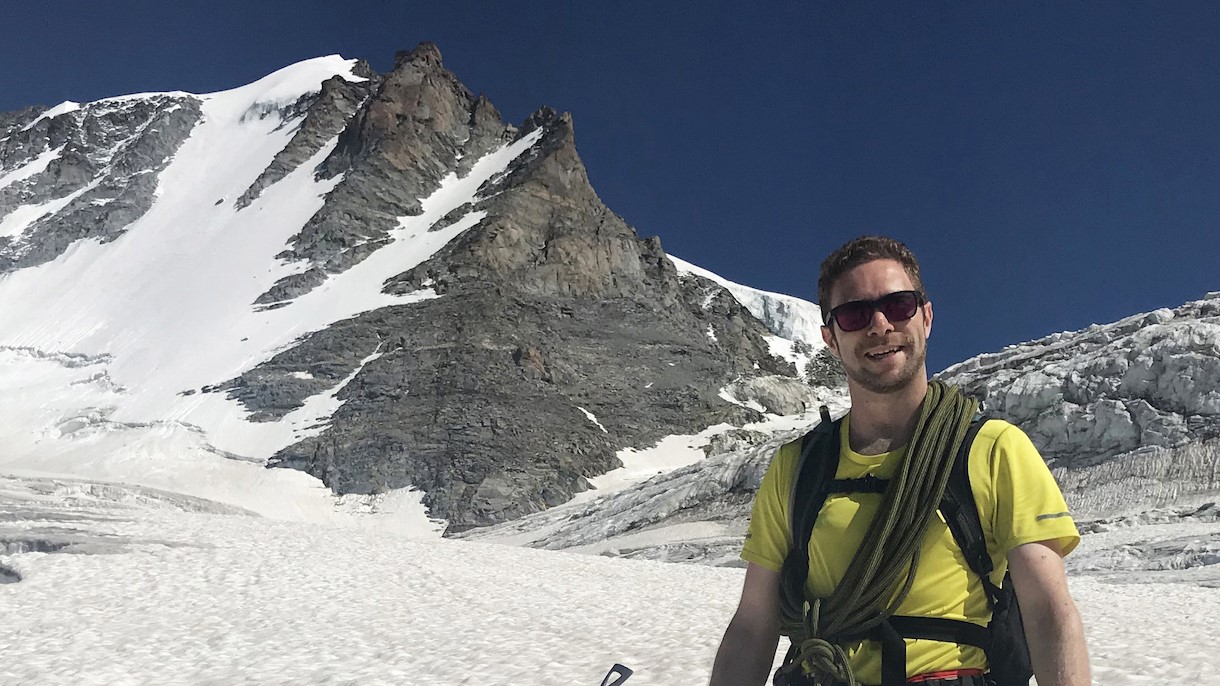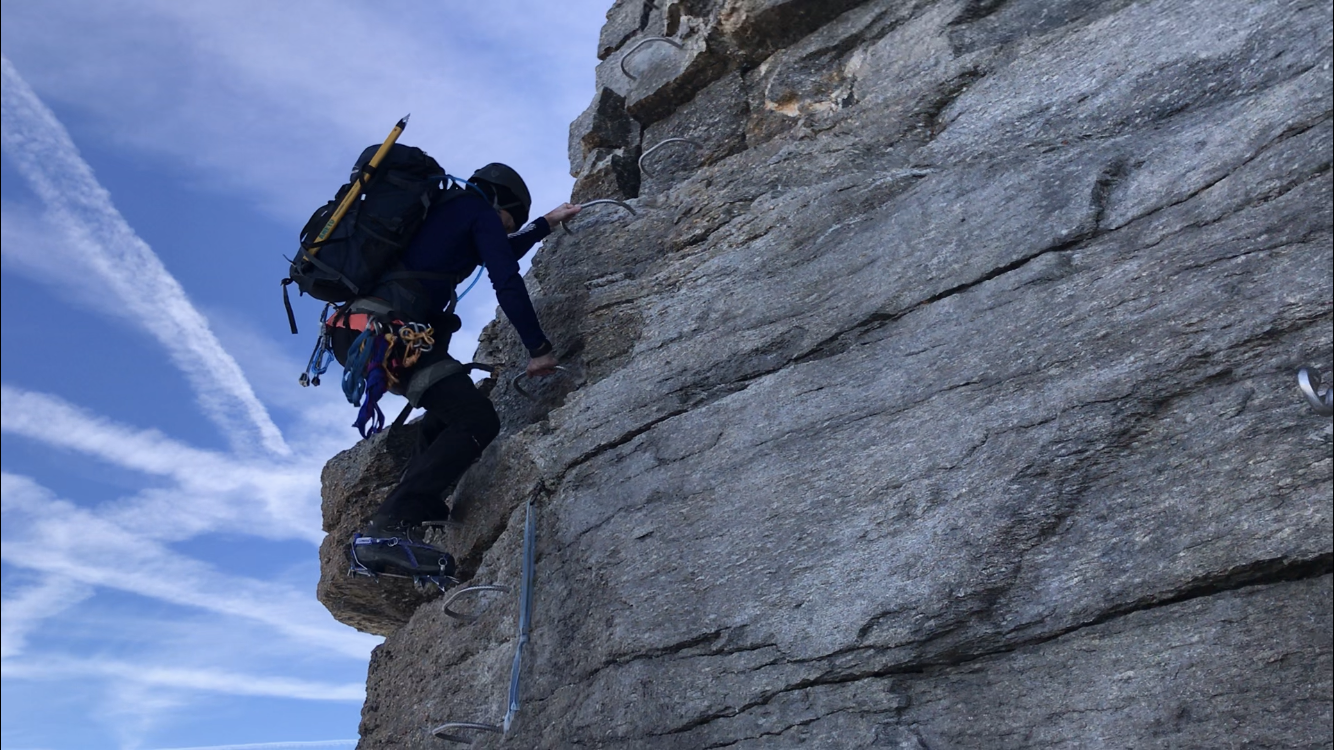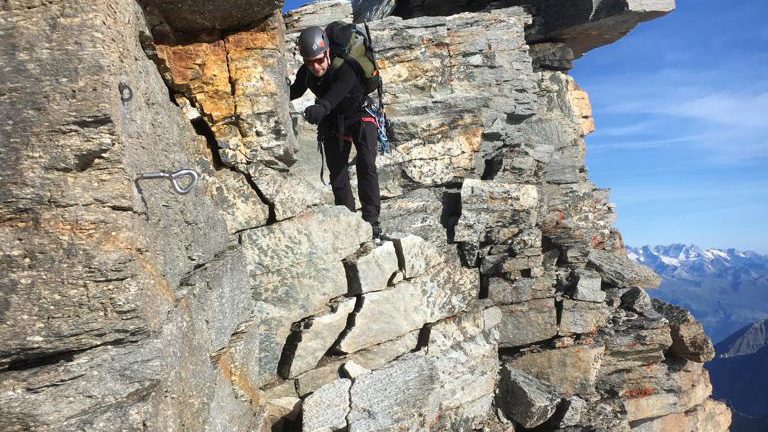
Set to the south of the Mont Blanc massif in a national park that bears its name, Gran Paradiso is a spectacular mountain that towers to 4,061 meters, making it the highest peak entirely within Italy. It remains unspoilt by ski developments, funicular railways and cable cars. The national park status protects it from such infrastructure and in turn protects the many ibex, marmots and eagles that call this peaceful part of the Alps home.
Gran Paradiso was my first alpine peak back in the heady summer of 2019. Graded F (facile – easy in French), its lack of technical difficulty makes it perfect for beginners and many people use it to acclimatize for an attempt on Mont Blanc, the highest peak in the Alps. My friend, and fellow London Mountaineering Club member, Mirek had climbed a handful of alpine peaks a number of years before and was keen to join me on the expedition. As I was a total newbie to alpinism, he’d be my guide of sorts. We planned an ascent from a campsite in the valley via Rifugio Chabod, a mountain hut we’d use as basecamp the night before the final ascent.

All in all, the mission went remarkably smoothly. We enjoyed a magnificent sunrise across Mont Blanc, soaked in the views towards the Matterhorn and Monte Rosa from the top and enjoyed the scramble across the summit’s rocky crest in our winter hiking boots. We were back at the hut before noon and enjoyed a leisurely descent back to the campsite. For the aspects of the trip that we got right, scroll down to the bottom of the page.
However, there were things I wish I’d known before my first alpine peak too, things that I’ve since adapted for future forays into the high mountains. Here are my top five...
Meet the expert
1: Better safe than sorry

Gran Paradiso is a popular mountain. Every year during the peak season, it’s ascended by thousands of adventurous souls and, as such, the routes to the summit are well-trodden. We’d practised glacier travel rope techniques prior to the trip and again during a recce from the Chabod hut to the glacier the day before our summit bid. However, when we reached the glacier on the day of our ascent, we decided to leave our rope in the pack and press on without it, prioritizing speed over safety.
This is not something I’d ever do again.
A year later, Mirek and I were chatting to another friend from the London Mountaineering Club who’d managed to climb Gran Paradiso during the summer of 2020, when Covid restrictions briefly relaxed before the wave of second lockdowns began. He’d taken the same route as we had, though his tale was somewhat more dramatic.

Partway into the ascent, he and his guide, who were roped together, momentarily left the main route up the glacier to pass a slower moving party. Without warning, a snow bridge collapsed and his guide disappeared into the abyss of a crevasse. Survival instinct took hold and our friend managed to dig his ice axe in and stop himself from being pulled in too. The same group they’d been seeking to overtake rushed over and, together, they hauled the guide out of the icy void.
This story underlines the importance of roping up on a glacier and taking every precaution you can when dealing with the alpine environment. Had the guide not been attached to our friend, the outcome would have been very different. Had either Mirek or I fallen into a crevasse during our adventure, we'd probably not be here to tell the tale. It’s always better to be safe than to be sorry.
2: Difficult sections are sometimes protected

The Alps are far from an untouched wilderness. The Golden Age of Alpinism, when mostly British climbers accompanied by local guides achieved many of the range's first ascents, ended in 1865 with Edward Whymper’s ill-fated ascent of the Matterhorn. In the 150+ years that have followed, the pursuit has become much more commercialized, and today we enjoy infrastructure that the early pioneers would only have dreamt of.
This infrastructure often includes protective aids on tricky or exposed sections, particularly on popular routes. On Gran Paradiso, this includes metal rungs that act as a ladder to attain the rocky crest, and bolts on the summit ridge that allow you to make a horrendously exposed scramble safer.
Mirek and I were able to make full use of the laddered section but, as we’d opted against using a rope, we tackled the scramble without protection. Thrilling, yes, but the thought of the sheer drop to the glacier below still sends shivers down my spine to this day.

3: A sleeping bag liner will do
Ice axes, crampons, ropes, winter hiking boots, helmets, first aid kits and all your hiking layers – the kit you need for ascending an alpine peak is somewhat heavier than your standard hiking setup. Add a three-season sleeping bag to this and the trek up from the valley to the hut, in the heat of the European summer sun, can feel like a bit of trudge.
Save space and weight in your backpack by taking a just sleeping bag liner rather than a full-on sleeping bag. I hadn’t realised, but this is what mountain huts – in both Europe and the States – recommend anyway and many insist on them for hygiene reasons. The dorm rooms in alpine huts tend to get rather stuffy during summer nights thanks to the radiated body heat of the amassed hikers and mountaineers. A sleeping bag liner provides a cooler, more comfortable sleep than a sleeping bag. When you’re up at 2:30am to make the most of the frozen conditions, every minute of shuteye is incredibly precious.
4: It’s worth booking an extended trip

Once I’d done my first alpine peak, I was raring to go and do more. Mirek and I were now in tune with each other, we’d gone to the effort of travelling to the Alps, we’d sorted our insurance, sharpened our skills and we were fully acclimatized after our successful ascent of a 4,000-meter peak. It would have made sense to continue the adventures.
Unfortunately, we only had one more full day before our flights back to the UK, which isn’t anywhere near enough to rest, regroup, hike back up to a hut and summit another high mountain. When we planned the trip, we’d been so transfixed on the idea of Gran Paradiso as the main objective that we hadn’t seen the potential for further alpine adventure. The lesson here is that it’s always worth booking a few more days of annual leave and making such a trip to the mountains a longer one.
5: Stay close to the action
After a few days in the admittedly idyllic Valsavarenche, we started to feel like something was missing. Sure, the untouched nature of Gran Paradiso National Park was glorious and the few places we’d found to eat in the valley were pretty decent, even if there wasn’t much of an atmosphere come the nighttime. However, for our last couple of nights, we struck our tents, loaded everything in the car and headed to the alpine adventure capital of Chamonix.

The buzz and energy of somewhere like Chamonix is infectious and suddenly we were spoilt with things to do and places to eat and drink. Everything was just that little bit easier, as the town’s facilities are tailored towards hikers and mountaineers. It’s simply the place to be, the ideal HQ from which to strike out from.
Of course, it all depends on what you’re after but for soaking up the lively atmosphere and having all the amenities you need, you can’t beat a Chamonix or a Zermatt or an Innsbruck.
Aspects we got right
With the more experienced Mirek leading the way, there were plenty of aspects that we got right, aspects that novices might not think of.

We made sure we had appropriate insurance. The cost of helicopter rescue in the Alps is eyewatering and then there’s the emergency hospital care to consider too. Various policies exist and it’s vital to get yourself appropriately covered.
We chose a sensible objective. When venturing into a higher and more serious mountain environment for the first time, it’s a good idea to be within your comfort zone when it comes to the technical difficulty of your chosen route. Mountaineering routes are usually rated to give you an idea of their difficulty. Choose wisely.
We practiced glacier rescue techniques prior to the trip. I was living in London at the time and we met in East London’s Haggerston Park to go through the various techniques, using a tree as our anchor. Of course, we made the mistake of not putting our rope-work skills into practice on the summit day, which we were lucky to get away with.

We booked a couple of nights at the hut to give us flexibility. This increased the likelihood of a good weather window and therefore the chances of success. Some huts may be happy to refund an unused second night too, though this isn’t always the case. Staying in a hut the night before the final ascent allows you to acclimatize better than heading straight up from the valley.
We did a recce of the route to the glacier the day before the final ascent. The first few hours of summit day will be spent in the dark, which makes navigation trickier. When you arrive at the hut the day before, there’s usually plenty of daylight left. Use this time to do a thorough recce of the route ahead so that you can switch into autopilot the morning after. This helps with speed and speed equals safety.

On summit day, we were up and out first in the early morning, making the most of the frozen conditions pre-sunrise. Once the sun comes up and starts to warm the frozen stuff it makes the environment that bit more dangerous. The likelihood of falling into a crevasse, of avalanches occurring, of seracs collapsing and of rockfall all increase. We were back before noon. “You guys are fast,” the hut warden congratulated us.
We drank plenty of water to stay hydrated, which is a massive help when it comes to the altitude and staying sharp while on the mountain.







